When I was a French major at Amherst College in the early 1960s, I had NO IDEA a half-century later I would be double billed as Biographer/Deltiologist. I wrote the first biography or life story of an Amherst alum from the class of 1879 Henry Clay Folger who––with his Vassar-educated wife Emily––founded the Folger Shakespeare Library on Capitol Hill (COLLECTING SHAKESPEARE: THE STORY OF HENRY AND EMILY FOLGER). Deltiology refers to the collection and analysis of (primarily vintage) picture postcards.
While at Amherst, I dated a young French lady who was studying in my home town of Wellesley, Mass. as an American Field Service exchange student. She helped me with my imperfect subjunctive, which led to not a total surprise when we married two years after my college graduation during my stint as a Peace Corps Volunteer in Cote d’Ivoire. While we are no longer married, our union spanned two centuries.
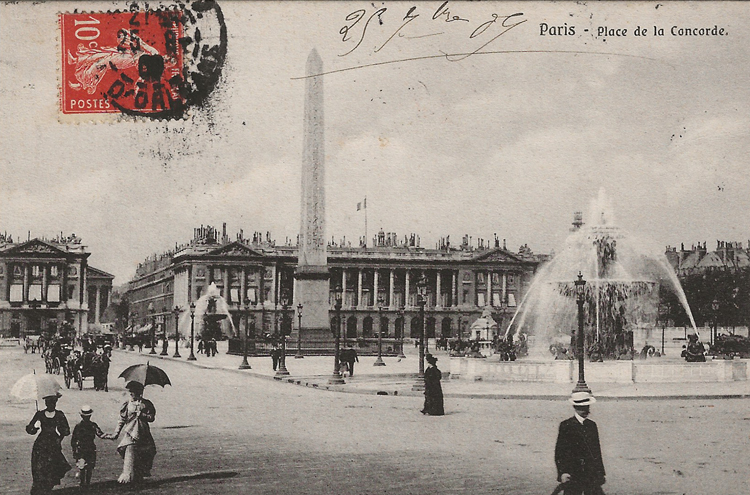
POSTCARD 1
During the union we visited together––and eventually with our two children––many interesting spots in France. It’s time to take a selective deltiological tour. Annick Pasquet was born in the 17th arrondissement of Paris during the difficult days of WWII. Her younger brother Alain Pasquet was also born in Paris. Their uncle Bernard Pasquet lived in the 20th arrondissement, next to a flower shop across from metro Pont de Vincennes. POSTCARD 1 of the “Place de la Concorde,” Paris was sent to Bourg (Ain) the year my father (Amherst College 1930) was born, 1909.
The 3,000-year-old granite obelisk in the center of the Place de la Concorde had been erected next to its twin outside the Temple of Luxor in Upper (southern) Egypt by Pharaoh Ramses II. I walked by the twin during the 1980s when I worked in the education office of USAID in Cairo and we were building schools in rural areas. In 1830, Pasha Mohamed Ali, ruler of Egypt, in a good-will gesture offered one of the pair of obelisks to King Louis-Philippe of France. The King, in exchange, gave the Pasha a mechanical clock which lies in the clock-tower of the Cairo Citadel. It has never worked! Who knew? I believe many of the readers of this post have seen the obelisk monument (located near the American Embassy) with its addition of a gold-leaf cap placed in 1998 under President Jacques Chirac.
I purchased this postcard at Carré Marigny, near the Marigny Theatre in the 8th arrondissement, near metro George V, and a short walk from the Place de la Concorde. This area first started as a weekend flea market dedicated to philately. Later the stamp collectors welcomed their first cousins, the postcard collectors. Thirdly, telephone cards were added as a momentary rage, and fourthly, pins. While you can find postcards sur les quais chez les bouquinistes where they are sold en vrac, at Marigny and in postcard boutiques they are sorted for your convenience. By country, Paris by arrondissement, France by two-digit codes (83 for Bouches-du-Rhône, 44 for Loire Atlantique, 20 for Corsica), and by theme (tobacco, steamships, saucy, etc.).
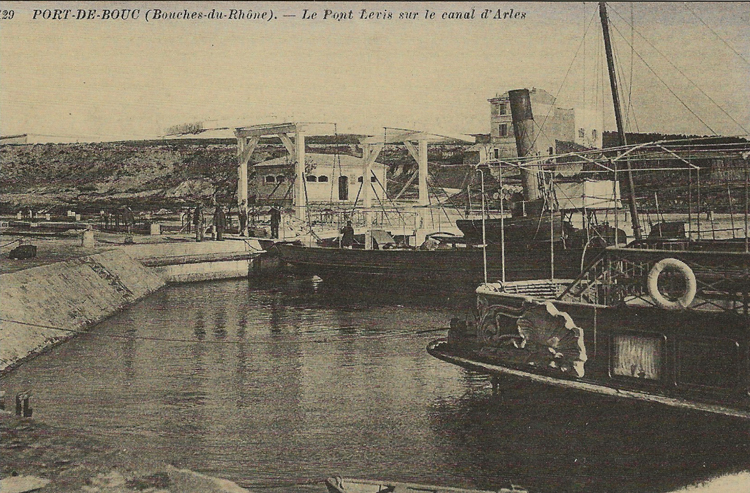
POSTCARD 2a
POSTCARD 2a depicts Port-de-Bouc, an industrial city in the Department of Bouches-du-Rhône on the Mediterranean, in particular the city’s “pont levis sur le canal d’Arles.” I remember driving to Port-de-Bouc with Annick in the 1990s. She showed me the neighborhood in which her family lived. Much had changed; she did not find the house, but a nearby sports bar had survived. What is notable about this postcard is its other side, usually used for the address.
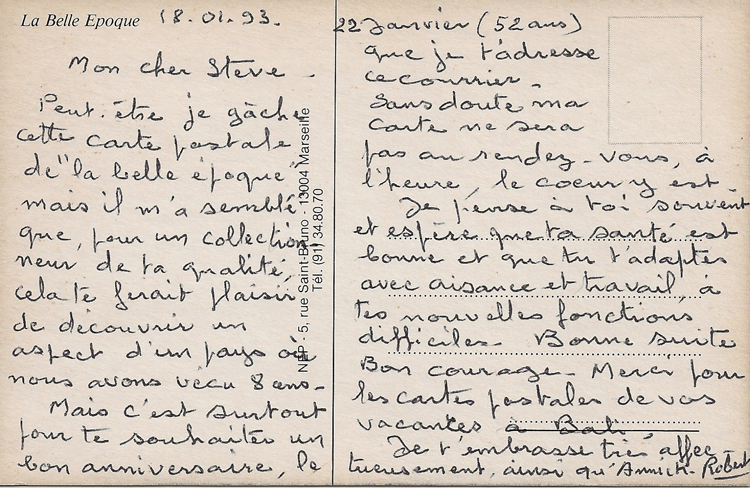
POSTCARD 2b
On this side––POSTCARD 2b––my late father-in-law Robert Pasquet penned a most moving greeting to me on my 52nd birthday. At the outset, he fears he will spoil the postcard by writing on it. Au contraire, Robert enriches it. Robert refers to Bali toward the end; I served as a Foreign Service officer in Indonesia for four years. Annick taught French and English at the French lycée in Jakarta. In my family it was my mother who kept track of family birthdays; in Annick’s it was “Papa Robert.” Annick’s brother Jean-Louis Pasquet was born in Port-de-Bouc.
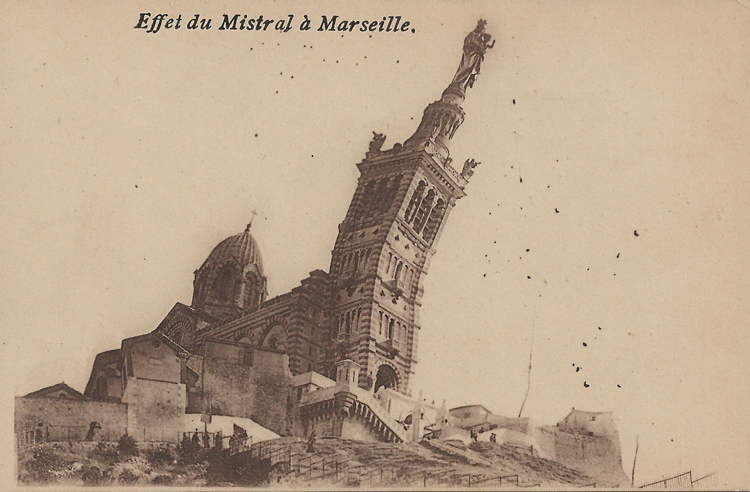
POSTCARD 3
My former wife had attended a lycée « pilote » on the outskirts of Marseille, Marseilleveyre. Marseille is also in the Department of Bouches-du-Rhône. Marseille’s best-known symbol, the Catholic basilica Notre-Dame de la Garde in the city center on a hill feels it when the strong, cold, northwesterly « mistral » wind blows. See « Effet du Mistral à Marseille, » the sepia POSTCARD 3 from the 1920s.
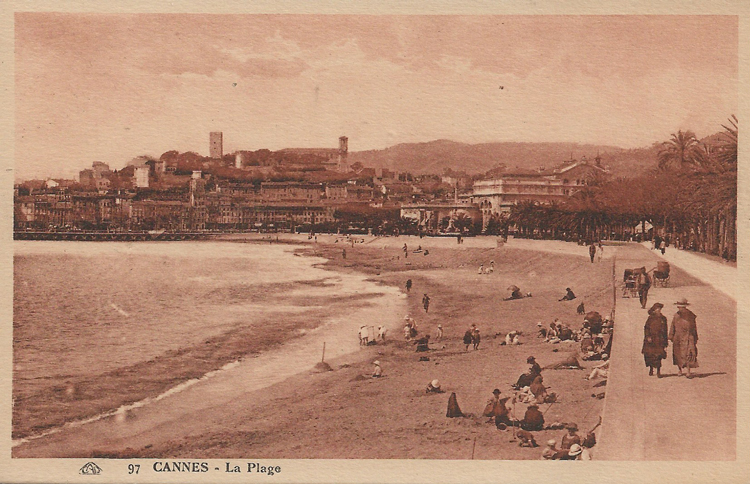
POSTCARD 4
One hundred miles to the east of Marseille on the Mediterranean Sea is the city of Cannes, in the Department of Alpes-Maritimes, code 06, in this sepia POSTCARD 4 of « La Plage » produced in Strasbourg. A second postcard of that city, « Cannes, le port, » POSTCARD 5, goes back to the first decade of the 20th century.
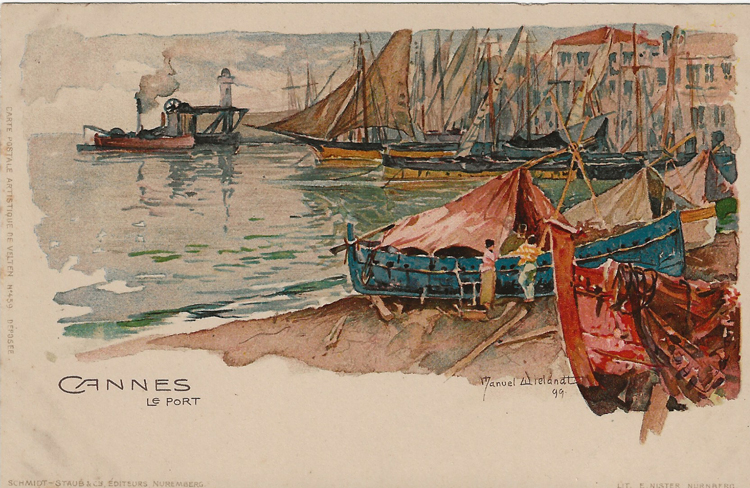
POSTCARD 5
This colorful card was produced in Nuremberg. The Germans were known for their superior printing presses during the golden age of postcards, 1900–1930. The artist is named Manuel Wielandt, and the year of the painting was 1899. Born in Lowenstein, (Baden-Württemberg) Germany in 1863, Wielandt died in 1922. He reveled in painting ports along the French and Italian Rivieras. His oil paintings adorn exactly 106 postcards, of which I am the proud owner of two, Cannes and Nice.
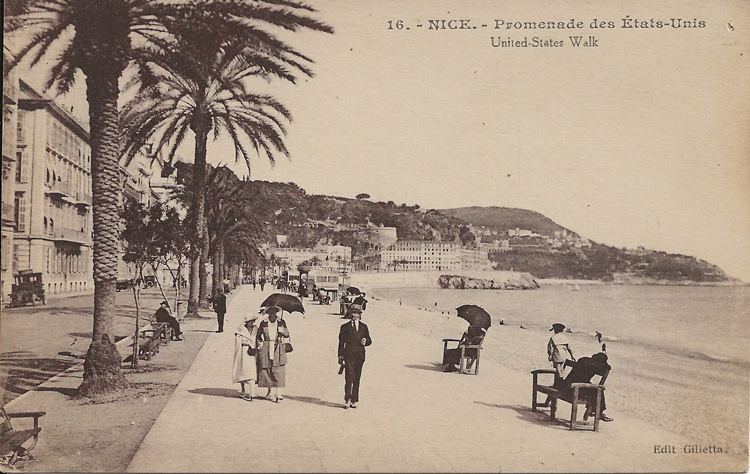
POSTCARD 6
Twenty-five miles further to the east of Cannes is the much larger port city of Nice, the capital of Alpes-Maritimes. POSTCARD 6 of the « Promenade des Etats-Unis » in Nice was produced in Nice, It extends from the Nice-Côte d’Azur airport on the west to the Quai des Etats-Unis on the east, or a distance of 4 miles along the Mediterranean. Compared to the sandy beach in Cannes, the beach in Nice consists of largish round pebbles or « galets. »
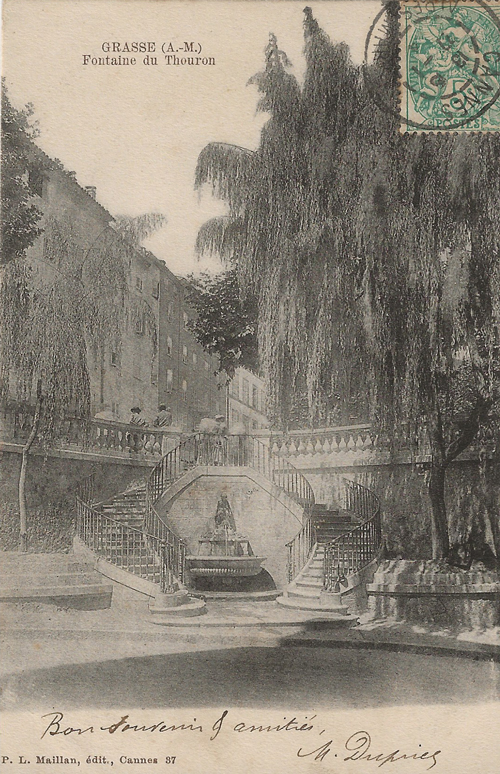
POSTCARD 7
Now let’s touch down on the inland perfume city of Grasse, also in Alpes Maritimes, where my former wife’s family has lived for decades. When you walk through the vieille ville, you can sniff the aroma of lavender in the stone walls built centuries ago. Grasse lies 12 mi. from Cannes and 27 mi. from Nice. I was married in Grasse, and so were my children. POSTCARD 7 of « Fontaine du Thouron » shows an area of the city and a curious double stairway we have all gone up and down countless times. In the middle is a bronze statue of a nymph holding a lyre, installed in 1887, but mysteriously stolen in 1992. This black-and-white POSTCARD 7 was sent in 1904 to Montargis (Loiret), where my late father-in-law Robert Pasquet was born. Annick’s sister Joëlle and brother Philippe Pasquet were both born in Grasse.
I will share two more postcards with you in this initial post of POSTCARDS OF FRANCE. They depict two towns that I have never visited. However, Annick lived there with her family when she was growing up and would evoke life there from time to time. Consequently, when I went to postcard sales or flea markets in France I added La Ferté-sous-Jouarre and Lizy-sur-Ourcq to my list of what I was seeking. Don’t you just love those names? They are both towns in the Department of Seine-et-Marne. They are eight miles apart. The Seine and Marne Rivers are in the Ile-de-France region of north central France.
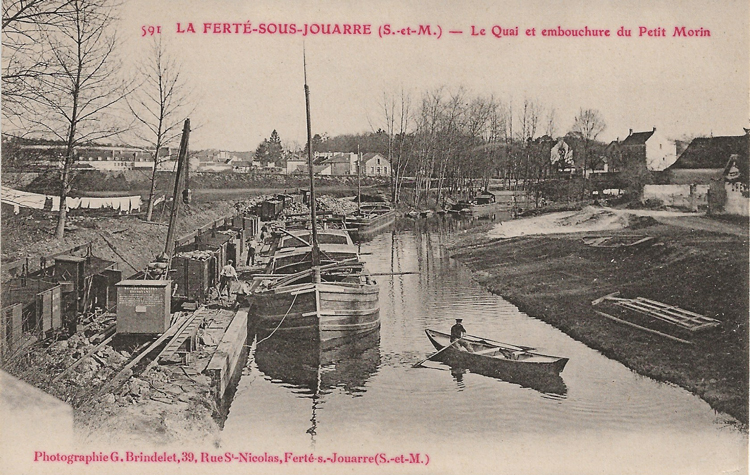
POSTCARD 8
POSTCARD 8 « 591 LA FERTÉ-SOUS-JOUARRE (S.et-M.) ––Le Quai et embouchure du Petit Morin » identifies the photographer of this bucolic river scene, G. Brindelet, as well as the studio address. Good advertising. The serial number 591 is extremely useful, as many postcard producers establish sets; when you get 591 you might want to look for 590 or 592 for other views of that particular location. Annick’s sister Michele Pasquet was born in La Ferté-sous-Jouarre.
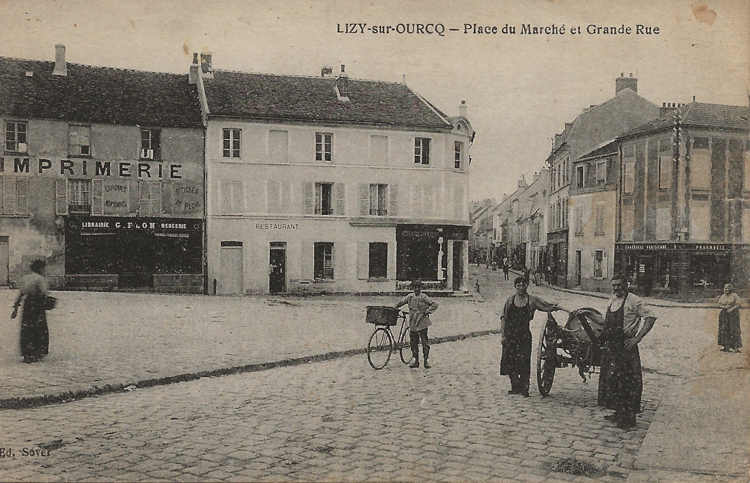
POSTCARD 9a
POSTCARD 9a shows the « Place du Marché et Grande Rue » of Lizy-sur OURCQ. In the lower left you see the name of the publisher, Sover. In this market place one can (with some difficulty) distinguish these businesses : imprimerie, couronnes mortuaires, librairie mercerie G. Flon, a restaurant, and pharmacie parisienne. Three people have stopped to pose for the photographer ; the other two who are nearby are unaware of their possible postcard fame.
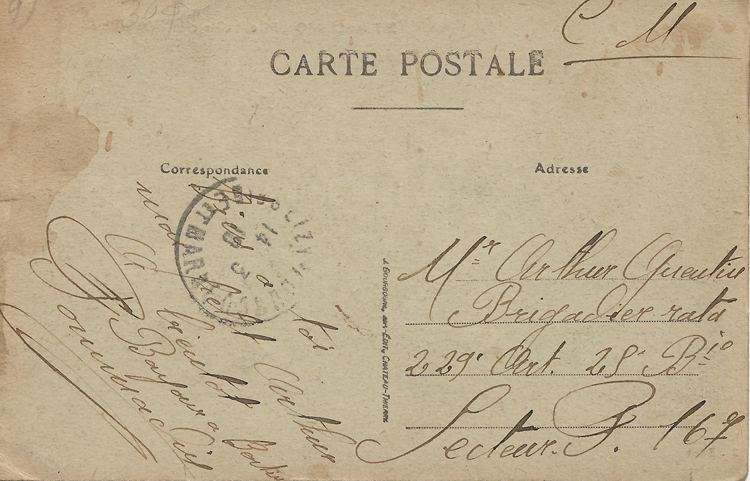
POSTCARD 9b
The more interesting aspect of this postcard may be the address side, POSTCARD 9b. The postmark allows the deltiologist to decipher LIZI S/ OURCQ SEINE ET MARNE. The date indicates Mar. 14, 1910. The correspondent’s message is a tender greeting, « Bien à toi mon petit Arthur » and the closing, « A bientôt » followed by an illegible signature. Anyone care to try their hand at deciphering the signature? The postcard is addressed to Mr Arthur Quentin, Brigadier rata, 229e Art. 29e Bie, Secteur P 167. There you have it: rank (brigadier), unit (229th artillery regiment, 29th battery), and postal sector (167). « Rata » is a synonym for « poilu, » a slang allusion (regarding their moustaches or beards) to common soldiers around the period of WWI. There is no sign of a postage stamp on either side of the postcard. None was required as military correspondence (C.M.) was free. Mail carriers in France knew exactly how to interpret « postal sector 167, » but you wouldn’t want to give away your coordinates to the enemy, would you?
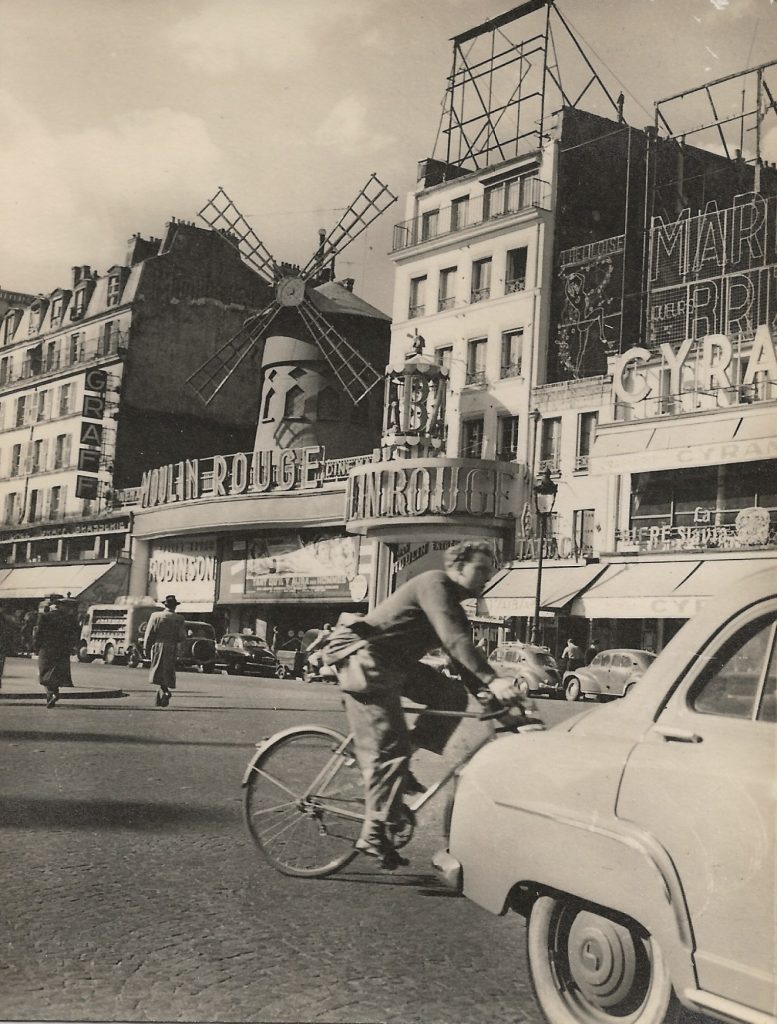
POSTCARD 10a
POSTCARD 10b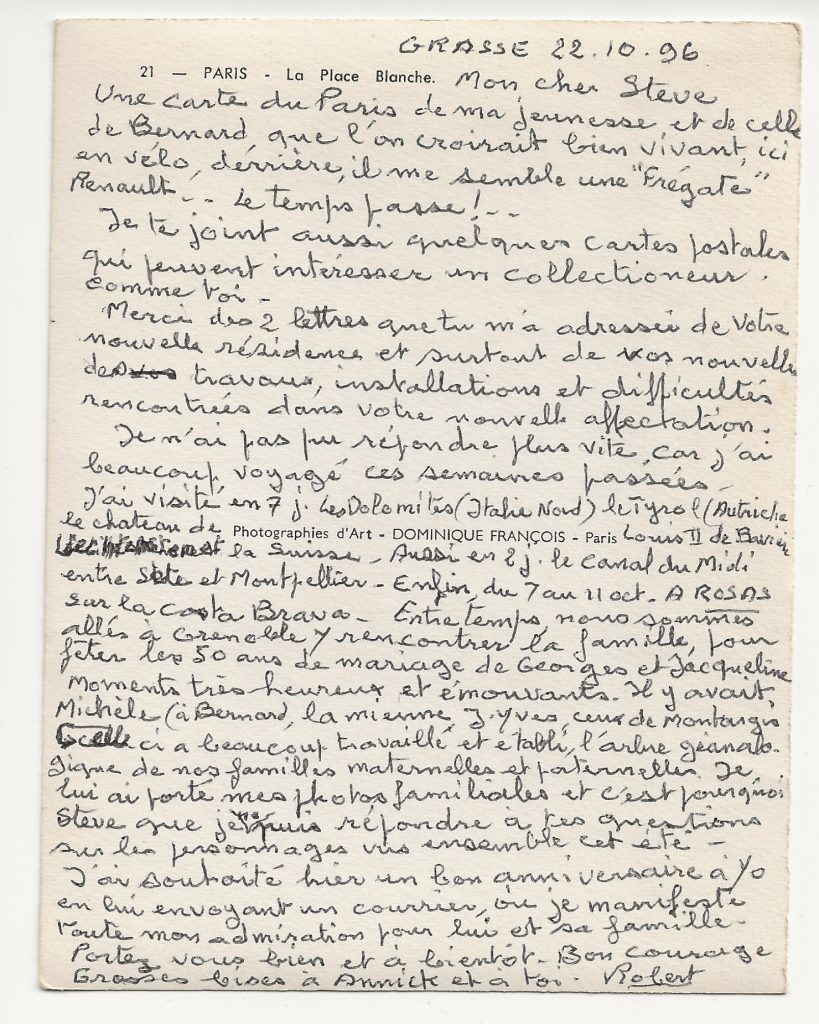
Three years after his postcard (2a-2b above) of Port-de-Bouc, my father-in-law Robert Pasquet sent me a postcard of La Place Blanche in Paris. Robert grew up in Montargis, an hour’s train ride south of Paris. He admits to reliving his youth in contemplating this postcard he sent me when I was in my last Foreign Service assignment in El Salvador, which he would soon visit in 1996. By the shape of the head, the cyclist behind the car resembles remarkably Robert’s late younger brother (and only sibling), Bernard, who died in 1991. At one time Robert owned a “frégate,” an executive saloon car made by Renault; that is the make of car on the right. In 10b, Robert announces that he is thoughtfully sending me other cards for my collection. Little could he or I know that a quarter of a century later I would be posting his correspondence, in which he reports having wished happy birthday to my son.
The next stop on a deltiological tour of France will be in Brittany.
COMMENTS:
10 Comments
Submit a Comment
CONNECT

Marvelous article, Steve. I learned Some new things about my own family!
Excellent, excellent, cher Steve….un beau voyage culturel à travers des cartes postales choisies en lien avec ta vie personnelle au cours de tes “jeunes” années en France, en Afrique…c’est du beau travail…je comprends mieux à présent ton intérêt pour ce jeune brigadier rata dont l’adresse en en secteur postal 167…
Moi aussi ! 🙂
Thank you, Stephen. I am struck by earlier times: many fewer people, no crowds like today. Even on the beach there are no swimmers. Carriages, but no cars, no telephone poles. Simpler times? Would be fun to look at pictures like these when reading contemporaneous history or literature.
Wonderful article which takes one on a virtual voyage throughout France and history!
The postcards themselves are priceless, and to have your personal history with each of them, and your very helpful and amusing commentary, makes this a striking package. Looking forward to the next installment!
Mon dieu!
Que tu as bien voyagé et collectionne de jolies et intéressantes choses !
Et je pensais que j’avais trouvé des cartes “artistiques” et intéressantes !
On a more personal note: reading all this makes me regret not having gotten to know you better at Amherst, that first year in Stearns as Dave’s roommate was such a loss pour moi!
You had theater, I believe, in addition to French, I was generally at a loss my 4 years, almost transferred to Berkeley after sophomore year.
Much more to discuss!
Steve, I learned a lot about you and a new word as well. The new word was deltiologist. Thanks. Furthermore, we both majored in French in college, me French and Philosophy at Middlebury graduating in 1961. I attended university in France the year before I went to Middlebury. We were also both assigned in Abidjan with the Foreign Service. Now all we have to do is meet in person one of these days when the pandemic is behind us. As a true Francophile I enjoyed the cards and the history they tell.
Ton ami, Peter
How very cool, Peter. What years were you in ABJ and who was Ambo? I’ve an M.A. from Middlebury in French; summer in Barrett Hall, courses with Claude Bourcier (sang in his choir). The Visiting was Pierre-Henri Simon, head of French School that year Jean Boorsh of Yale.
I learned a lot about parts of France that I barely knew. I spent 8 days in Cannes in 1982 on my way home from Cairo after 5 years to get to know a cousin my age who had lived there all her life. Then 8 days on a bateau mouche in Paris staying with my younger cousin who was living there with his fiancee and her daughter. The boat was about a block or two from Ecole Veterinaire metro stop and showed a part of the real Paris, far from the tourist spots, but a cheap fare 35 minutes or so from the Louvre. Steve takes us to small towns through the eyes of his wife’s family. Steve writes well with lots of info but not turgidly. It is an easy read and very enjoyable.